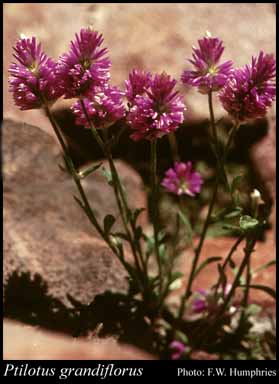- Reference
- Fragm. 1:237 (1859)
- Conservation Code
- Not threatened
- Naturalised Status
- Native to Western Australia
- Name Status
- Current
Ascending annual, herb, (0.01-)0.1-0.6 m high. Fl. pink-purple-red, Jul to Oct. Red loam, sand, clayey sand, sandstone, limestone. River banks, tops of gorges.

Scientific Description
Annuals, stems several, more or less prostrate or more or less erect, glabrescent or glabrous, with nodose hairs. Leaves present, 5-80 mm long, 1-10 mm wide, glabrescent or glabrous, with nodose hairs; basal rosette absent; cauline leaves alternate. Spikes pink or magenta, ovoid or cylindrical, solitary or clustered, with densely arranged flowers. Bracts 4.4-5.5 mm long, colourless, glabrous, awned or mucronate, with an obscure midrib. Bracteoles 4.4-5.3 mm long, colourless, glabrous, awned or mucronate, with an obscure midrib. Outer tepals 6-9.6 mm long, not entire. Inner tepals 6-9.6 mm long, with a basal tuft of hairs on inner face. Style 1.1 mm long, curved or straight, centrally or obliquely fixed to ovary. Distribution: South West and Eremaean Botanical Region; IBRA regions: Carnarvon, Coolgardie, Gascoyne, Murchison, Yalgoo.
Distribution
- IBRA Regions
- Avon Wheatbelt, Carnarvon, Coolgardie, Geraldton Sandplains, Murchison, Yalgoo.
- IBRA Subregions
- Eastern Goldfield, Eastern Murchison, Edel, Geraldton Hills, Merredin, Southern Cross, Tallering, Western Murchison, Wooramel.
- Local Government Areas (LGAs)
- Chapman Valley, Coolgardie, Cue, Greater Geraldton, Meekatharra, Mount Magnet, Murchison, Northampton, Perenjori, Sandstone, Shark Bay, Upper Gascoyne, Yalgoo, Yilgarn.